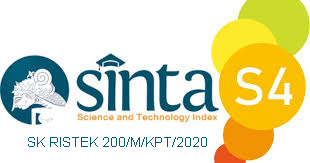Prediction of Electrical Energy Consumption Using LSTM Algorithm with Teacher Forcing Technique
Abstract
Electrical energy is an important foundation in world economic growth, therefore it requires an accurate prediction in predicting energy consumption in the future. The methods that are often used in previous research are the Time Series and Machine Learning methods, but recently there has been a new method that can predict energy consumption using the Deep Learning Method which can process data quickly for training and testing. In this research, the researcher proposes a model and algorithm which contained in Deep Learning, that is Multivariate Time Series Model with LSTM Algorithm and using Teacher Forcing Technique for predicting electrical energy consumption in the future. Because Multivariate Time Series Model and LSTM Algorithm can receive input with various conditions or seasons of electrical energy consumption. Teacher Forcing Technique is able lighten up the computation so that it can training and testing data quickly. The method used in this study is to compare Teacher Forcing LSTM with Non-Teacher Forcing LSTM in Multivariate Time Series model using several activation functions that produce significant differences. TF value of RMSE 0.006, MAE 0.070 and Non-TF has RMSE and MAE values of 0.117 and 0.246. The value of the two models is obtained from Sigmoid Activation and the worst value of the two models is in the Softmax activation function, with TF values is RMSE 0.423, MAE 0.485 and Non-TF RMSE 0.520, MAE 0.519.
Keywords
Full Text:
PDFReferences
T. Ula, “Dampak Konsumsi Energi Terbarukan Terhadap Pertumbuhan Ekonomi: Studi di Asia Tenggara,” J. Econ. Sci., vol. 5, no. 2, pp. 26–34, 2019.
dkk Ahmad Wahid, “Analisis Kapasitas Dan Kebutuhan Daya Listrik Untuk Menghemat Penggunaan Energi Listrik Di Fakultas Teknik Universitas Tanjungpura,” J. Tek. Elektro UNTAN, vol. 2, no. 1, p. 10, 2014.
O. Somantri, “Prediksi Kebutuhan Permintaan Energi Listrik Menggunakan Neural Network Berbasiskan Algoritma Genetika,” no. September, pp. 1–135, 2015.
S. Seyedzadeh, F. P. Rahimian, I. Glesk, and M. Roper, “Machine learning for estimation of building energy consumption and performance: a review,” Vis. Eng., vol. 6, no. 1, 2018, doi: 10.1186/s40327-018-0064-7.
M. Alanbar, A. Alfarraj, and M. Alghieth, “Energy consumption prediction using deep learning technique case study of computer college,” Int. J. Interact. Mob. Technol., vol. 14, no. 10, pp. 166–177, 2020, doi: 10.3991/ijim.v14i10.14383.
B. Shyti and D. Valera, “The Regression Model for the Statistical Analysis of Albanian Economy,” Int. J. Math. Trends Technol., vol. 62, no. 2, pp. 90–96, 2018, doi: 10.14445/22315373/ijmtt-v62p513.
B. Cetişli and A. Barkana, “Speeding up the scaled conjugate gradient algorithm and its application in neuro-fuzzy classifier training,” Soft Comput., vol. 14, no. 4, pp. 365–378, 2010, doi: 10.1007/s00500-009-0410-8.
A. Abubakar et al., “A support vector machine classification of computational capabilities of 3D map on mobile device for navigation aid,” Int. J. Interact. Mob. Technol., vol. 10, no. 3, pp. 4–10, 2016, doi: 10.3991/ijim.v10i3.5056.
N. Karimtabar, S. Pasban, and S. Alipour, “Analysis and predicting electricity energy consumption using data mining techniques - A case study I.R. Iran - Mazandaran province,” 2015 2nd Int. Conf. Pattern Recognit. Image Anal. IPRIA 2015, no. Ipria, pp. 0–5, 2015, doi: 10.1109/PRIA.2015.7161634.
Y. J. Lee and H. J. Choi, “Forecasting building electricity power consumption using deep learning approach,” Proc. - 2020 IEEE Int. Conf. Big Data Smart Comput. BigComp 2020, pp. 542–544, 2020, doi: 10.1109/BigComp48618.2020.000-8.
S. Nallathambi and K. Ramasamy, “Prediction of electricity consumption based on DT and RF: An application on USA country power consumption,” Proc. - 2017 IEEE Int. Conf. Electr. Instrum. Commun. Eng. ICEICE 2017, vol. 2017-Decem, no. 1, pp. 1–7, 2017, doi: 10.1109/ICEICE.2017.8191939.
S. Chan, I. Oktavianti, and V. Puspita, “A Deep Learning CNN and AI-Tuned SVM for Electricity Consumption Forecasting: Multivariate Time Series Data,” 2019 IEEE 10th Annu. Inf. Technol. Electron. Mob. Commun. Conf. IEMCON 2019, pp. 488–494, 2019, doi: 10.1109/IEMCON.2019.8936260.
H. Lim, Y. Kim, C. Y. Lee, and K. Cheun, “An Efficient Sliding Window Algorithm Using Adaptive-Length Guard Window for Turbo Decoders,” J. Commun. Networks, vol. 14, no. 2, pp. 195–198, 2012, doi: 10.1109/JCN.2012.6253068.
T. Y. Kim and S. B. Cho, Predicting the Household Power Consumption Using CNN-LSTM Hybrid Networks, vol. 11314 LNCS. Springer International Publishing, 2018.
A. Sherstinsky, “Fundamentals of Recurrent Neural Network (RNN) and Long Short-Term Memory (LSTM) network,” Phys. D Nonlinear Phenom., vol. 404, no. March, pp. 1–43, 2020, doi: 10.1016/j.physd.2019.132306.
S. Goodman and N. Ding, “TeaForN : Teacher-Forcing with N-grams,” pp. 8704–8717, 2020.
F. Karim, S. Majumdar, H. Darabi, and S. Harford, “Multivariate LSTM-FCNs for time series classification,” Neural Networks, vol. 116, pp. 237–245, 2019, doi: 10.1016/j.neunet.2019.04.014.
K. Drossos, S. Gharib, P. Magron, and T. Virtanen, “Language modelling for sound event detection with teacher forcing and scheduled sampling,” arXiv, no. October, 2019, doi: 10.33682/1dze-8739.
A. A. Ismail, T. Wood, and H. C. Bravo, “Improving long-horizon forecasts with expectation-biased LSTM networks,” arXiv, 2018.
A. Goyal, A. Lamb, Y. Zhang, S. Zhang, A. Courville, and Y. Bengio, “Professor forcing: A new algorithm for training recurrent networks,” Adv. Neural Inf. Process. Syst., no. Nips 2016, pp. 4608–4616, 2016.
A. S. Wardana and M. I. Ananta Timur, “Collaborative Filtering Recommender System pada Virtual 3D Kelas Cendekia,” IJEIS (Indonesian J. Electron. Instrum. Syst., vol. 8, no. 1, p. 73, 2018, doi: 10.22146/ijeis.28729.
C. E. Nwankpa, W. Ijomah, A. Gachagan, and S. Marshall, “Activation functions: Comparison of trends in practice and research for deep learning,” arXiv, pp. 1–20, 2018.
Julpan, E. B. Nababan, and M. Zarlis, “Analisis Fungsi Aktivasi Sigmoid Biner Dan Sigmoid Bipolar Dalam Algoritma Backpropagation Pada Prediksi Kemampuan Siswa,” J. Teknovasi, vol. 02, no. 1, pp. 103–116, 2015.
M. Çelebi and M. Ceylan, “The New Activation Function for Complex Valued Neural Networks: Complex Swish Function,” no. July 2019, pp. 169–173, 2019, doi: 10.36287/setsci.4.6.050.
N. Ahmad Syaripul and A. Mukharil Bachtiar, “Visualisasi Data Interaktif Data Terbuka Pemerintah Provinsi Dki Jakarta: Topik Ekonomi Dan Keuangan Daerah,” J. Sist. Inf., vol. 12, pp. 15–29, 2016.
C. V. Gonzalez Zelaya, “Towards explaining the effects of data preprocessing on machine learning,” Proc. - Int. Conf. Data Eng., vol. 2019-April, pp. 2086–2090, 2019, doi: 10.1109/ICDE.2019.00245.
M. Sangiorgio and F. Dercole, “Robustness of LSTM neural networks for multi-step forecasting of chaotic time series,” Chaos, Solitons and Fractals, vol. 139, p. 110045, 2020, doi: 10.1016/j.chaos.2020.110045.
A. Yadav, C. K. Jha, and A. Sharan, “Optimizing LSTM for time series prediction in Indian stock market,” Procedia Comput. Sci., vol. 167, no. 2019, pp. 2091–2100, 2020, doi: 10.1016/j.procs.2020.03.257.
O. Contribution, “Nonlinear Neural Networks: Principles, Mechanisms, and Architectures,” Pattern Recognit. by Self-Organizing Neural Networks, vol. 1, 2020, doi: 10.7551/mitpress/5271.003.0004.
H. H. Chieng, N. Wahid, O. Pauline, and S. R. Kishore Perla, “Flatten-T Swish: A thresholded ReLU-Swish-like activation function for deep learning,” arXiv, vol. 4, no. 2, pp. 76–86, 2018.
DOI: https://doi.org/10.31326/jisa.v4i1.904
Refbacks
- There are currently no refbacks.
Copyright (c) 2021 Sasmitoh Rahmad Sas Riady, Tjong Wan Sen

This work is licensed under a Creative Commons Attribution-ShareAlike 4.0 International License.
JOURNAL IDENTITY
Journal Name: JISA (Jurnal Informatika dan Sains)
e-ISSN: 2614-8404, p-ISSN: 2776-3234
Publisher: Program Studi Teknik Informatika Universitas Trilogi
Publication Schedule: June and December
Language: English
APC: The Journal Charges Fees for Publishing
Indexing: EBSCO , DOAJ, Google Scholar, Arsip Relawan Jurnal Indonesia, Directory of Research Journals Indexing, Index Copernicus International, PKP Index, Science and Technology Index (SINTA, S4) , Garuda Index
OAI address: http://trilogi.ac.id/journal/ks/index.php/JISA/oai
Contact: jisa@trilogi.ac.id
Sponsored by: DOI – Digital Object Identifier Crossref, Universitas Trilogi
In Collaboration With: Indonesian Artificial Intelligent Ecosystem(IAIE), Relawan Jurnal Indonesia, Jurnal Teknologi dan Sistem Komputer (JTSiskom)
JISA (Jurnal Informatika dan Sains) is Published by Program Studi Teknik Informatika, Universitas Trilogi under Creative Commons Attribution-ShareAlike 4.0 International License.


















